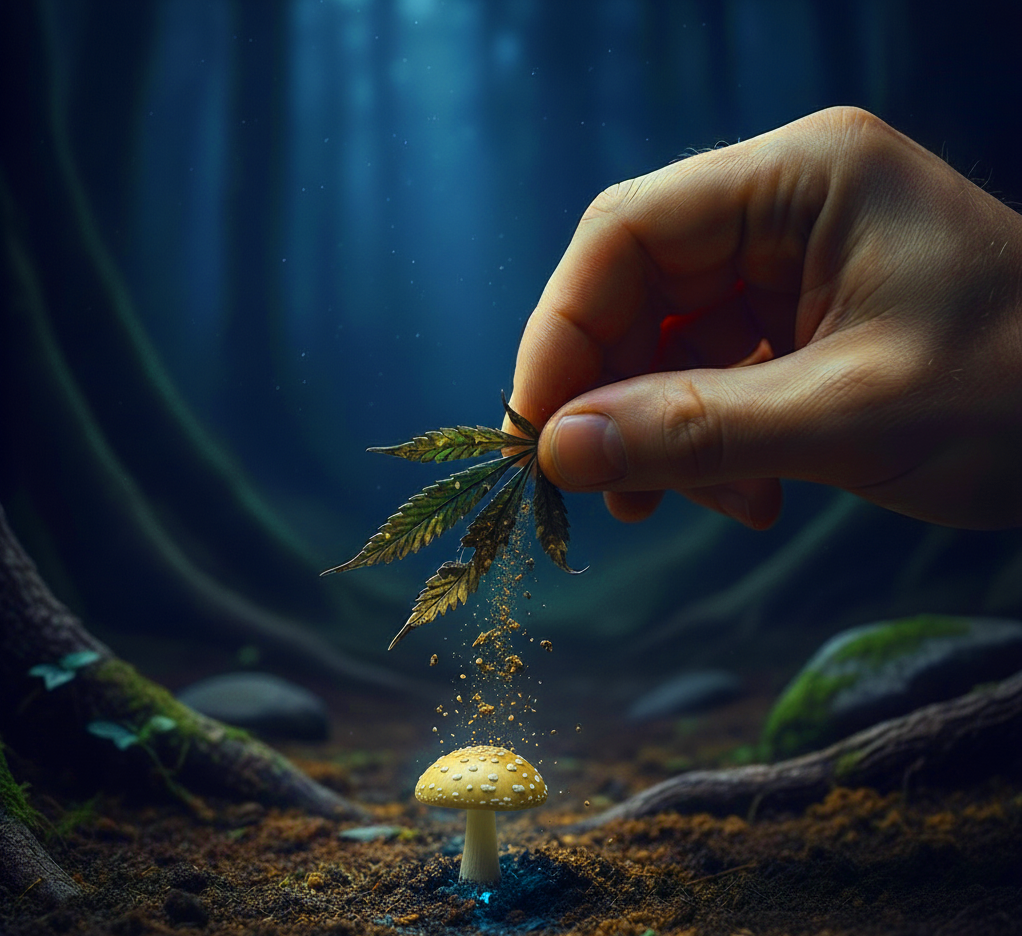The great migration: From cannabis to psychedelics
The cannabis party is over, and the hangover is real. The shockwave has shaken the entire sector—from small growers to major corporations. The case of Bruce Linton — the man who propelled Canopy Growth to the top of the multibillion-dollar market — illustrates how leading figures are abandoning the cannabis industry to bet on psychedelics. His departure is not an isolated event but the most visible symptom of a silent exodus: the capital and talent that fueled the “green gold rush” are now seeking a new promised land in emerging markets.

This phenomenon raises two fundamental questions that this article seeks to answer. First, what are the underlying causes of this massive flight from an industry that, until recently, seemed unstoppable? And second, and even more importantly, what crucial lessons must the emerging psychedelic movement learn to avoid repeating the chronicle of a foretold collapse?
Act I: The cannabis exodus
To understand why capital and talent are leaving the cannabis industry, we first need to grasp the anatomy of its implosion. Far from a sudden failure, it was the result of a perfect storm of economic, financial, and regulatory factors that dismantled the initial promise.
The hangover of the “Green Gold Rush”
Stock market collapse and loss of confidence in cannabis
Initial optimism faded, leaving many investors with catastrophic losses. It wasn’t just a market correction; it was a full-blown stock market collapse. Shares of major publicly traded giants like Canopy Growth, Aurora, and Tilray, once the industry’s flagships, have fallen more than 90% from their peaks. This financial disaster wiped out billions in value and, worse, destroyed the trust of a market that mistook enthusiasm for sustainability.
Market saturation and cannabis price crash
Legalization unleashed fierce competition that quickly turned a once premium product into a mere commodity. In mature markets like California, Oregon, and Canada, massive overproduction caused wholesale prices to collapse to historic lows. The result was a brutal paradox: in a sector undergoing legal expansion, for many farmers it was no longer profitable even to harvest, strangled by a market where supply far exceeded real demand.
Regulatory and fiscal strangulation: The perfect storm
Add to this scenario disproportionate taxation and labyrinthine bureaucracy that devoured already thin profit margins. Far from being the free market some envisioned, the cannabis industry found itself entangled in a web of regulations that were complex and often contradictory. The result has been a true operational crisis: hundreds of small and medium-sized businesses—often the idealistic entrepreneurs who started the movement—have gone bankrupt or been absorbed under unfavorable terms, unable to compete in a game designed for deep-pocketed corporations capable of withstanding years of losses.
The dawn of psychedelics

While the cannabis sector was collapsing under the weight of its own excesses, another movement was gaining momentum—more quietly and strategically. For capital and talent seeking a new horizon, the appeal of the psychedelic market lies not only in novelty but also in fundamentally different foundations.
A therapeutic purpose and a favorable narrative
Unlike cannabis, whose legalization always floated between recreational and medicinal use, the psychedelic renaissance is anchored in a clear purpose: mental health. The potential of substances like psilocybin to treat severe conditions such as treatment-resistant depression, post-traumatic stress disorder (PTSD), and addictions is backed by growing, rigorous scientific evidence.
This academic legitimacy has generated an overwhelmingly positive media narrative, with prestigious publications such as Nature, The New England Journal of Medicine, and The New York Times treating the subject with a seriousness cannabis never enjoyed in its early days. This support attracts more sophisticated capital—investors less interested in short-term speculation and more focused on the potential for a genuine therapeutic revolution.
The emerging psychedelic market
From a strategic perspective, cannabis has become a “red ocean”: a saturated space where competitors fight over a basic product in a market with shrinking margins. Psychedelics, by contrast, represent a “blue ocean”: a new market where competition is still absent, and value is created through intellectual property and innovation.
The opportunities to develop and patent new compounds, therapeutic protocols, and technological platforms are immense. Those entering now not only have the chance to establish benchmark brands but also to build lasting competitive moats and shape an ecosystem from scratch, rather than fight for the crumbs of an already mature market.
Cannabis veterans can lead the change
Crucially, the players leading this migration are not idealistic newcomers. They are seasoned cannabis industry veterans who come armed with hard-earned lessons. They know how to navigate regulatory labyrinths, how to build brands in stigmatized sectors, and, above all, they understand firsthand the mistakes that led to the previous market implosion. They arrive scarred by battle, with a realism that could be their greatest asset in keeping the new psychedelic promise on track.
Thus, the exodus from cannabis is no mystery—it’s the story of a repeating market cycle. The psychedelic industry now finds itself at a strangely familiar starting point: standing at the same threshold of promise and peril that cannabis occupied a decade ago. The key difference, and the only hope for avoiding the same fate, lies in experience. But will hard-earned wisdom make any difference? For the answer to be yes, the new movement must internalize the three fundamental lessons its predecessor never learned.
Act II: Lessons for psychedelia

Building a conscious future for psychedelia is not a matter of idealism but of strategy. Avoiding the implosion that befell cannabis requires a radically different approach in three key areas that will define the movement’s course in the coming decade.
Go beyond medicine to ensure access
The cannabis movement used the medical argument as an effective Trojan horse to push legalization forward. However, this strategy came at a cost: it created complex regulatory systems that, once the recreational market was established, often left the original patients behind. With psychedelics, the risk is even greater. A purely pharmaceutical model centered on patents and high-cost clinical treatments threatens to create an ecosystem accessible only to an elite.
The lesson is clear: while scientific rigor is non-negotiable, the goal must be equitable access. This means exploring regulated models beyond the strictly clinical, such as wellness centers or assisted therapeutic use, preventing the promise of psychedelia from being locked behind multimillion-dollar patents and out of reach for most people.
Even today, the movement oscillates between two poles: the community-driven model of MAPS, which seeks to make psychedelic therapy a public good, and the corporate vision of Compass Pathways, which treats it as a protected pharmaceutical innovation. The resolution of this tension will determine whether psychedelia becomes a medicine for the soul or a luxury product.
Foster a culture of intention, not excess
Part of the stigma still haunting cannabis stems from a public culture that, at times, glorified overconsumption. This image became ammunition for opponents of legalization and hindered its broader social acceptance. The psychedelic revolution cannot afford this mistake.
The public narrative must focus unequivocally on intention, respect, and integration. The image to project is not one of hedonistic excess but of therapeutic use, personal growth, and wellness. Winning society’s and lawmakers’ trust depends on presenting these substances not as an escape, but as tools for introspection and improvement. It’s a cultural battle that must be fought with responsibility and seriousness.
Organize now to avoid being devoured later
The cannabis industry was slow to organize politically, allowing major corporations and well-funded lobby groups to dictate the rules of the game—often at the expense of small producers and pioneering activists. The psychedelic community must learn from this passivity.
This is the classic David versus Goliath battle: the grassroots community—scientists, therapists, activists, and small entrepreneurs—facing the looming arrival of Big Pharma and powerful investment funds. It’s crucial that this collective organize now to build a unified lobbying front. The goal is to influence legislation from the start, ensuring that future regulations uphold the movement’s principles, promote fair competition, and prevent psychedelia’s future from being shaped solely in corporate boardrooms.
A future yet to be written

The great migration from cannabis to psychedelics is much more than a portfolio reshuffle. It is, above all, a second chance. We arrive at this new frontier with the map of a recent implosion: the lessons of the “green gold rush” trace the paths we must not take again. Because the course of this movement is not yet written. A future of equitable access and mindful use is not a certainty, but a fragile ideal we must build and defend.
The arrival of purely speculative capital is imminent. The key question is not whether market logic will dilute psychedelia’s promise, but what mechanisms the community will put in place to ensure that it doesn’t.
This concerns us all: visionary investors, ethical therapists, activists with memory, and hopeful users. The crossroads is not merely between consciousness and greed, but between deliberate construction and negligent repetition. History is watching. It’s time to show that this time, we’ve learned how to navigate.
If cannabis was the party, psychedelia can be the awakening. But only if we remember what it feels like to open our eyes after a hangover.




















